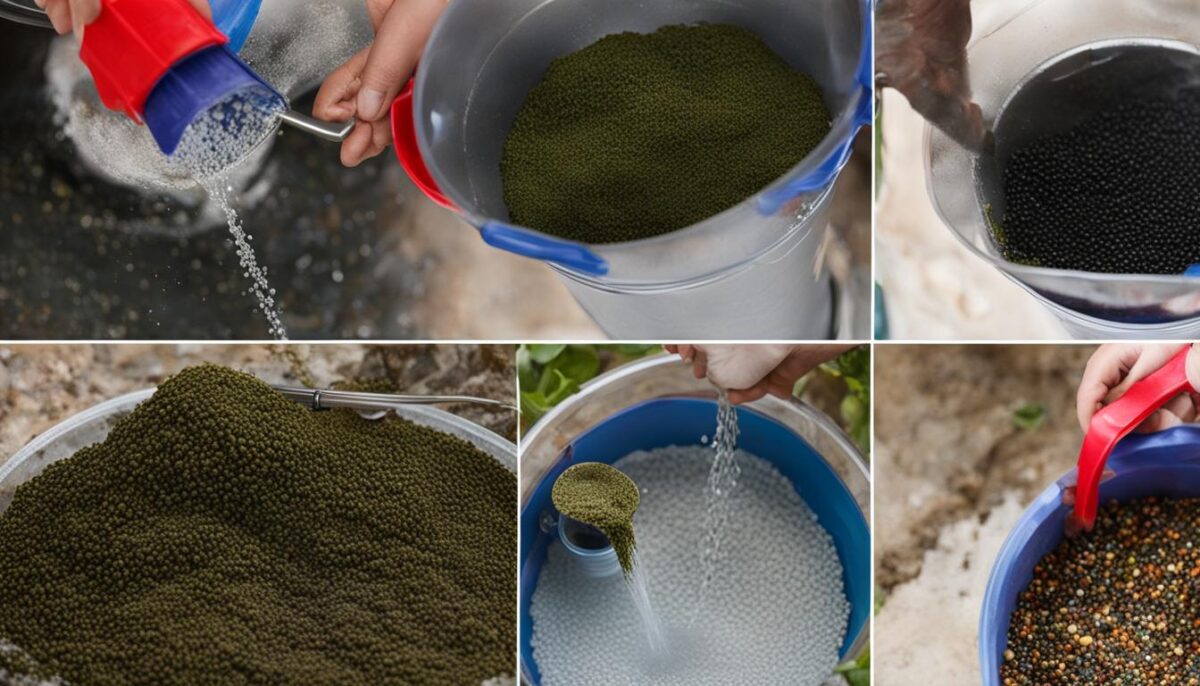Keeping your betta fish tank clean is essential for the health and happiness of your pet. Regular cleaning and maintenance ensures a safe and comfortable environment for your betta to thrive. In this guide, we will walk you through the step-by-step process of cleaning your betta fish tank to keep it in optimal condition.
Key Takeaways:
- Regular cleaning and maintenance are vital for your betta fish tank.
- A clean tank reduces stress, prevents diseases, and improves water conditions.
- Gather all the necessary supplies and tools before starting the cleaning process.
- Follow the step-by-step guide to ensure a thorough and efficient cleaning.
- Schedule regular cleaning sessions and monitor water parameters for the best care.
Prepare for Cleaning: Essential Supplies and Tools
Before you start cleaning your betta fish tank, it’s important to gather all the necessary supplies and tools. Having these items ready will make the cleaning process efficient and convenient.
Here are the essential cleaning supplies and tools you will need:
- Fresh, Dechlorinated Water: Ensure you have a supply of clean water to replace the old water in your betta fish tank. You can use a water conditioner to remove harmful chemicals like chlorine.
- Bucket: Use a bucket to hold the water during the cleaning process.
- Aquarium Vacuum or Siphon: This tool is used to clean the gravel at the bottom of the tank and remove debris.
- Algae Scraper: An algae scraper helps to remove algae buildup from the glass walls of the tank.
- Water Testing Kit: It’s important to regularly check the water parameters of your betta fish tank. A water testing kit will help you monitor ammonia, nitrite, nitrate levels, and pH balance.
- Towels or Paper Towels: Keep towels or paper towels handy to clean up any spills or drips.
- Fish Net: Use a fish net to temporarily relocate your betta to a safe place during the cleaning process.
- Aquarium-Safe Cleaners: If needed, choose cleaners specifically designed for aquarium use to clean stubborn stains or deposits. Make sure they are safe for your betta fish.
- Waste Bag: Have a waste bag or trash bag ready for proper disposal of debris and waste materials.
- Optional Rubber Gloves: Consider wearing rubber gloves for hand protection, especially if you have sensitive skin or allergies.
Having these supplies and tools on hand will ensure that you are fully prepared before starting the cleaning process. By having everything readily available, you can efficiently clean your betta fish tank and maintain a healthy environment for your beloved betta.
Step-by-Step Guide to Cleaning a Betta Fish Tank
Cleaning a betta fish tank is an important part of maintaining a healthy environment for your pet. Follow these step-by-step instructions to ensure a clean and comfortable home for your betta.
- Prepare the Area: Start by organizing all your cleaning supplies and finding a suitable work area. Choose a well-lit space away from direct sunlight and make sure you have easy access to a water source for filling and rinsing.
- Remove Your Betta: Carefully scoop your betta fish out of the tank using a fish net and place it in a clean and secure container filled with the water from the tank. This will keep your betta safe during the cleaning process.
- Drain the Tank: Begin by siphoning out the water from the tank using an aquarium vacuum or siphon. Start at one end of the tank and move the siphon along the substrate to remove any debris or waste. Be thorough, but avoid removing all of the gravel as it hosts beneficial bacteria that help maintain a healthy nitrogen cycle in the tank.
- Clean the Decorations: Take out any decorations, plants, or ornaments from the tank and gently scrub them with a soft brush or sponge. Rinse them thoroughly under running water to remove any dirt or algae build-up. Avoid using soap or detergents, as they can be harmful to your betta.
- Clean the Glass: Use an algae scraper or a non-abrasive sponge to clean the inside of the tank glass. Scrub in gentle, circular motions to remove any algae or hard water stains. Rinse the glass thoroughly after cleaning to ensure no residue remains.
- Replace the Water: Fill a clean bucket with fresh, dechlorinated water that is about the same temperature as the existing tank water. Slowly pour the water back into the tank, taking care not to disturb the substrate or decorations. Fill the tank to the appropriate level, leaving enough space for your betta to swim comfortably.
- Condition the Water: Add a water conditioner to the tank to remove any chlorine or chloramine present in the fresh water. Follow the instructions on the product label for the correct dosage.
- Acclimate Your Betta: Before returning your betta to the tank, it’s important to acclimate it to the new water conditions. Slowly add small amounts of the tank water to the container holding your betta, allowing it to adjust gradually. After about 15 minutes, you can carefully release your betta back into the freshly cleaned tank.
- Monitor and Maintain: Once the tank is cleaned and your betta is back home, monitor the water parameters regularly using a water testing kit. This will help you maintain the correct pH, ammonia, and nitrite levels in the tank. Perform routine partial water changes and cleanings to keep your betta fish tank in optimal condition.
By following these step-by-step betta tank cleaning instructions, you can ensure a clean and healthy environment for your beloved betta fish.
Conclusion
Regularly cleaning and maintaining your betta fish tank is of utmost importance to ensure the health and well-being of your betta fish. Keeping their tank clean not only reduces stress and prevents diseases but also improves the overall water conditions for your pet.
By following the proper cleaning steps and using the right supplies, you can create a clean and comfortable environment for your betta to thrive. Remember to schedule regular cleaning sessions to maintain optimal tank conditions and monitor the water parameters to provide the best care for your beloved betta fish.
Here are a few betta fish tank cleaning tips to keep in mind:
- Perform partial water changes regularly to remove any accumulated waste and maintain water freshness.
- Use an aquarium vacuum or siphon to clean the gravel and remove any debris or uneaten food.
- Scrape off algae from the glass walls using an algae scraper or a soft pad, ensuring your betta has clear visibility.
- Avoid using harsh chemicals or cleaners that may be harmful to your betta. Stick to aquarium-safe cleaning solutions.
By following these simple tips and establishing a regular maintenance routine, you can keep your betta fish tank clean, safe, and enjoyable for your betta fish to call home.
FAQ
Why is it important to clean my betta fish tank regularly?
Regular cleaning and maintenance of your betta fish tank is essential for the health and happiness of your pet. It ensures a safe and comfortable environment for your betta to thrive, reduces stress, prevents diseases, and improves water conditions.
What supplies and tools do I need to clean my betta fish tank?
To clean your betta fish tank, you will need fresh, dechlorinated water for replacement, a bucket for holding water, an aquarium vacuum or siphon for cleaning the gravel, an algae scraper for removing algae from the glass walls, a water testing kit to check water parameters, towels or paper towels for spills, a fish net for temporary relocation of your betta, aquarium-safe cleaners if needed, a waste bag for disposal, and optional rubber gloves for hand protection.
What are the steps to clean a betta fish tank?
Cleaning a betta fish tank involves several important steps. Here is a step-by-step guide to help you through the process:
1. Gather all the necessary supplies and tools.
2. Carefully remove your betta fish from the tank using a fish net.
3. Empty a portion of the tank water into a bucket for replacement.
4. Use an aquarium vacuum or siphon to clean the gravel, removing any debris or waste.
5. Use an algae scraper to remove algae from the glass walls.
6. Test the water parameters using a water testing kit and make any necessary adjustments.
7. Refill the tank with fresh, dechlorinated water at the appropriate temperature.
8. Acclimate your betta fish back into the clean tank.
9. Dispose of the waste water and clean the used tools.
10. Monitor the tank and repeat the cleaning process regularly.

